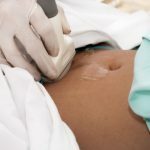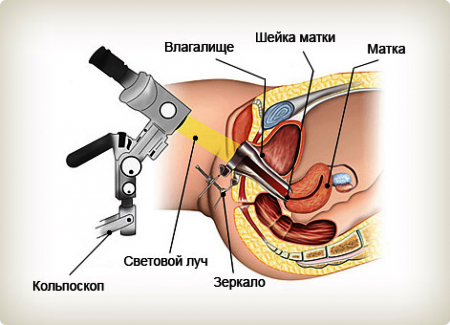The wide introduction of endoscopic research methods into everyday medical practice allowed gynecologists to reach a new level of detection and diagnosis of various pathologies in women. However, when carrying out such instrumental examinations, it is necessary to take into account the peculiarities of female physiology, for example, colposcopy is not recommended for menstruation.
Before beginning any medical manipulation, specialists should explain to the patient all the subtleties and side effects of the proposed research method. What should young ladies know about colposcopy?
survey The main indications for the instrumentalinspection
Gynecologists claim that the conduct of this study is shown to any woman even in the absence of complaints of any pathology of the sexual sphere.

The following main indications for the use of this type of endoscopy are distinguished:
- If the visual examination of the cervix, doctors have found changes in the structure of the mucosa.
- This diagnostic method is indicated when suspicious cells or other pathological manifestations from the tissues are present in the cytological smears from the vaginal cavity.
- Colposcopy before menstruation is usually performed if a woman is prepared for routine surgery on the uterus or ovaries.
As endoscopic research methods give specialists the opportunity to get a broader picture of the disease, the percentage of such manipulations has been steadily increasing lately.
Tasks that allow to solve the method
Specialists distinguish three main goals in the application of colposcopy in women. This includes:
- Punctual taking of biopsy smears from the cervix and vagina, which improves the quality of diagnosis of possible diseases.
- Conducting a differential examination of benign and malignant formations in the female genital area. This largely depends on the treatment tactics and the anticipated prognosis.
- General assessment of the condition of the epithelial layer of the vagina and cervix, localization of the focus of the pathological process.
In solving such problems, doctors use two basic types of research. Most experts stop at carrying out a simple colposcopy. This method in 70% of cases allows you to accurately assess the area and severity of the disease in a woman.
This method of research has proved itself well, when the urgency of the situation confronts the gynecologist is the question, you can do colposcopy with menstruation or not. In urgent cases, this simple study can help determine the overall picture of the disease in the patient.
In a more serious situation, gynecologists use the advanced colposcopy technique. When performing this manipulation, it is recommended to use special dyes and specific color filters to clarify the diagnosis. Most often doctors stop on a solution of acetic acid or lugol of weak concentration.
Prepare for the manipulation and fineness of the
research processColposcopy itself is a fairly simple and painless procedure. There are no special subtleties of preparation for it.
The only recommendation from doctors can be the use of a woman 3 to 4 days before the study of vaginal suppositories on the basis of "Betadina".It allows the patient to more carefully prepare the vaginal mucosa for the upcoming examination. Therefore, when a woman asks a gynecologist whether a colposcopy is done with a period of a month, the doctor should explain the possibility of distortion of the overall picture in the vagina and cervix during research in this period.

In the future, the cervix and vaginal walls are inspected with a colposcope. Study the surface usually clockwise to avoid omissions in the examination of tissues. If necessary, problem areas are stained with solutions of lugol and acetic acid.
Additional features of the
procedure In addition to establishing an accurate diagnosis, endoscopic instruments can also be used to treat identified pathological sites. These procedures are usually aimed at removing inflammation, stimulating the recovery of the epithelial layer, removing pathological areas of the cervical and vaginal tissues.
Additional techniques that exist in modern gynecological clinics:
- First of all it is laser coagulation. With the help of a special nozzle, the suspicious area is irradiated and the growth of healthy cells is stimulated.
- If the neck is affected by low temperatures, it is usually said that the cryosurgical method is used. It is based on the removal of affected tissue with liquid nitrogen.
- One of the most effective methods of treating such a pathology is diathermoconization. In this case, the cone-shaped excision of the affected area within the healthy tissues is performed. The effectiveness of this endoscopic treatment usually reaches 95%.The disadvantages of this method can be attributed to the fact that after colposcopy, the delay in menstrual periods is observed in 10-15% of women.
There are other treatment methods for such a contingent of patients. All these methods are based on the wide use of the colposcope.
Look at the video about the procedure:
Dependence of the quality of examination and treatment on the menstrual cycle
As with any method of diagnosis based on subjective factors, the result of using endoscopic equipment for examination of patients may depend on the physiological characteristics of the organism.
What is recommended by
experts An important factor in the quality of research is that many experts consider what day of the month they make colposcopy.
Most physicians in this field are of the opinion that the first half of the cycle can be considered the optimal period for such a study. The most reliable results are usually obtained on the 3rd - 5th day after the last menstruation, especially if the woman has performed special preparation of the vaginal mucosa with the help of suppositories with "Betadine".
However, there are often enough situations where, due to various reasons, such a study in this period of time was not implemented. And yet it is often necessary to solve the problem, whether it is possible to do colposcopy before menstruation.
In most gynecological clinics do not see much sense in such a study. The thing is that before the menstrual canal of the cervix is usually densely packed with a lot of mucus. This is a purely physiological condition, but it can significantly distort the overall picture of the state of internal genital organs.
Contraindications for endoscopy
Colposcopy is one of the safest and painless methods of instrumental examination of women. All possible restrictions are associated exclusively with the menstrual cycle of the patient. To obtain reliable results, such a study is preferred not to be assigned:
- During the maturation of the egg. The cervical canal of the cervix at this time is completely blocked by a large amount of mucus, which can distort the overall picture. Under the influence of sex hormones, the density and viscosity of mucus during ovulation significantly increases, making colposcopy absolutely pointless.
- It is not recommended to perform similar instrumental examinations at the height of menstrual bleeding .In addition to the fact that the presence of blood in the vagina significantly reduces the likelihood of obtaining an adequate result, possible mechanical damage to the vaginal wall during manipulation can provoke inflammation.
- In addition, any inflammatory process in the internal genital area itself is a contraindication to such a study. The provoked mucosa is always more susceptible to microbes and bacteria.
For the purpose of endoscopy, medics are usually advised to wait 2 to 3 weeks after the end of the treatment for the inflammatory processes of the female's internal genitalia.
 We recommend to read an article about ultrasound of the small pelvis with monthly. From it you will learn about the optimal time for passing the procedure, the indications for carrying out an ultrasound examination, and also the reasons why you can not post a sonogram.
We recommend to read an article about ultrasound of the small pelvis with monthly. From it you will learn about the optimal time for passing the procedure, the indications for carrying out an ultrasound examination, and also the reasons why you can not post a sonogram.
General rules for successful
survey Colposcopy after menstruation is the ideal solution. Before or at the time of ovulation, not only is it not recommended by specialists, but even forbidden. In clinical practice, there are no diseases that would require carrying out this study during critical days in a woman.
Most specialists recommend using cervical and vaginal examinations from 3 to 7 days of the patient's menstrual cycle. However, given the greater individuality of the cycle time for each woman, the decision on the date of colposcopy is taken in each individual case after examining and talking with the gynecologist with the lady.
Colposcopy refers to modern methods of diagnosis and treatment of diseases of the female genital area. Scrupulous execution of all instructions of the doctor will give the woman the opportunity to get qualified assistance of specialists in full.

